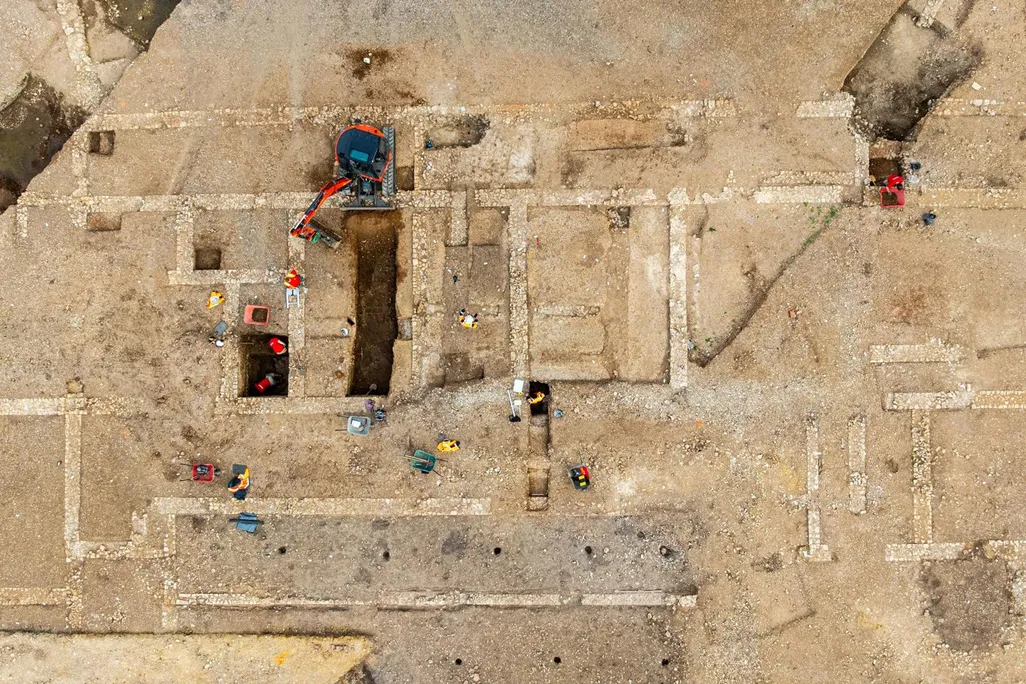Archaeologists Stumble Onto Sprawling Ancient Roman Villa During Construction of a Road in France
Cool Finds
Archaeologists Stumble Onto Sprawling Ancient Roman Villa During Construction of a Road in France
Located near Auxerre, the grand estate once possessed an exorbitant level of wealth, with thermal baths and heated floors
Aerial view of the villa, with thermal baths at the bottom right, the garden and fountain in the center, and the agricultural fields expanding to the left
Ch. Fouquin / INRAP
In ancient times, all roads led to Rome—or so the saying goes. Nowadays, new roads can lead to Roman ruins.
During construction on an alternative route to D606, a regional road just under two miles outside of Auxerre, in central France, salvage archaeologists unearthed a sprawling Roman villa complete with a stately garden, a fountain and an elaborate system of underfloor heating known as a hypocaust, according to a statement from the French National Institute for Preventive Archaeological Research.
While researchers have been aware of the ruins on the outskirts of the Gallo-Roman settlement of Autissiodorumsince the 19th century, previous excavations have been limited. The most recent dig, in 1966, found a 7,500-square-foot building with ten rooms and amenities that suggested its residents enjoyed great wealth and regional power.
The site of Sainte-Nitasse, adjacent to a regional highway
Ch. Fouquin / INRAP
But until now, the true scale of the villa known as Sainte-Nitasse and its surrounding agricultural estates along the River Yonne was unclear. Archaeologists at INRAP have since discovered a 43,000-square-foot building thought to date to between the first and third centuries C.E. It suggests a previously unimagined level of grandeur.
INRAP identifies the site as one of the “grand villas of Roman Gaul,” according to the statement. Grand villas are typified by their vast dimensions and sophisticated architectural style. They typically encompass both agricultural and residential portions, known in Latin as pars rustica and pars urbana, respectively. In the pars urbana, grand villas tend to feature stately construction materials like marble; extensive mosaics and frescoes; and amenities like private baths, fountains and gardens.
So far, the excavations at Sainte-Nitasse have revealed all these features and more.
The villa’s development is extensive. A 4,800-square-foot garden is enclosed by a fountain to the south and a water basin, or an ornamental pond, to the north. The hypocaust, an ancient system of central heating that circulated hot air beneath the floors of the house, signals a level of luxury atypical for rural estates in Roman Gaul.
A section of the villa's hypocaust heating system, which circulated hot air beneath the floor
Ch. Fouquin / INRAP
“We can imagine it as an ‘aristocratic’ villa, belonging to someone with riches, responsibilities—perhaps municipal, given the proximity to Auxerre—a landowner who had staff on site,” Alexandre Burgevin, the archaeologist in charge of the excavations with INRAP, tells France Info’s Lisa Guyenne.
Near the banks of the Yonne, a thermal bath site contains several pools where the landowner and his family bathed. On the other side of the garden, workers toiled in the fields of a massive agricultural estate.
Aside from its size and amenities, the villa’s level of preservation also astounded archaeologists. “For a rural site, it’s quite exceptional,” Burgevin tells L’Yonne Républicaine’s Titouan Stücker. “You can walk on floors from the time period, circulate between rooms like the Gallo-Romans did.”Over time, Autissiodorum grew to become a major city along the Via Agrippa, eventually earning the honor of serving as a provincial Roman capital by the fourth century C.E. As Gaul began slipping away from the Roman Empire around the same time, the prominence of the city fluctuated. INRAP archaeologists speculate that the site was repurposed during medieval times, around the 13th century.
Burgevin offers several explanations for why the site remained so well preserved in subsequent centuries. The humid conditions along the banks of the river might have prevented excess decay. Since this portion of the River Yonne wasn’t canalized until the 19th century, engineers may have already been aware of the presence of ruins. Or, perhaps the rubble of the villa created “bumpy,” intractable soil that was “not easy to pass over with a tractor,” he tells France Info.
While the site will briefly open to the public on June 15 for European Archaeology Days, an annual event held at sites across the continent, excavations will continue until September, at which time construction on the road will resume. Much work is to be done, including filling in large gaps of the site’s chronology between the Roman and medieval eras.
“We have well-built walls but few objects,” says Burgevin, per L’Yonne Républicaine. “It will be necessary to continue digging to understand better.”
Get the latest stories in your inbox every weekday.
#archaeologists #stumble #onto #sprawling #ancient
Archaeologists Stumble Onto Sprawling Ancient Roman Villa During Construction of a Road in France
Cool Finds
Archaeologists Stumble Onto Sprawling Ancient Roman Villa During Construction of a Road in France
Located near Auxerre, the grand estate once possessed an exorbitant level of wealth, with thermal baths and heated floors
Aerial view of the villa, with thermal baths at the bottom right, the garden and fountain in the center, and the agricultural fields expanding to the left
Ch. Fouquin / INRAP
In ancient times, all roads led to Rome—or so the saying goes. Nowadays, new roads can lead to Roman ruins.
During construction on an alternative route to D606, a regional road just under two miles outside of Auxerre, in central France, salvage archaeologists unearthed a sprawling Roman villa complete with a stately garden, a fountain and an elaborate system of underfloor heating known as a hypocaust, according to a statement from the French National Institute for Preventive Archaeological Research.
While researchers have been aware of the ruins on the outskirts of the Gallo-Roman settlement of Autissiodorumsince the 19th century, previous excavations have been limited. The most recent dig, in 1966, found a 7,500-square-foot building with ten rooms and amenities that suggested its residents enjoyed great wealth and regional power.
The site of Sainte-Nitasse, adjacent to a regional highway
Ch. Fouquin / INRAP
But until now, the true scale of the villa known as Sainte-Nitasse and its surrounding agricultural estates along the River Yonne was unclear. Archaeologists at INRAP have since discovered a 43,000-square-foot building thought to date to between the first and third centuries C.E. It suggests a previously unimagined level of grandeur.
INRAP identifies the site as one of the “grand villas of Roman Gaul,” according to the statement. Grand villas are typified by their vast dimensions and sophisticated architectural style. They typically encompass both agricultural and residential portions, known in Latin as pars rustica and pars urbana, respectively. In the pars urbana, grand villas tend to feature stately construction materials like marble; extensive mosaics and frescoes; and amenities like private baths, fountains and gardens.
So far, the excavations at Sainte-Nitasse have revealed all these features and more.
The villa’s development is extensive. A 4,800-square-foot garden is enclosed by a fountain to the south and a water basin, or an ornamental pond, to the north. The hypocaust, an ancient system of central heating that circulated hot air beneath the floors of the house, signals a level of luxury atypical for rural estates in Roman Gaul.
A section of the villa's hypocaust heating system, which circulated hot air beneath the floor
Ch. Fouquin / INRAP
“We can imagine it as an ‘aristocratic’ villa, belonging to someone with riches, responsibilities—perhaps municipal, given the proximity to Auxerre—a landowner who had staff on site,” Alexandre Burgevin, the archaeologist in charge of the excavations with INRAP, tells France Info’s Lisa Guyenne.
Near the banks of the Yonne, a thermal bath site contains several pools where the landowner and his family bathed. On the other side of the garden, workers toiled in the fields of a massive agricultural estate.
Aside from its size and amenities, the villa’s level of preservation also astounded archaeologists. “For a rural site, it’s quite exceptional,” Burgevin tells L’Yonne Républicaine’s Titouan Stücker. “You can walk on floors from the time period, circulate between rooms like the Gallo-Romans did.”Over time, Autissiodorum grew to become a major city along the Via Agrippa, eventually earning the honor of serving as a provincial Roman capital by the fourth century C.E. As Gaul began slipping away from the Roman Empire around the same time, the prominence of the city fluctuated. INRAP archaeologists speculate that the site was repurposed during medieval times, around the 13th century.
Burgevin offers several explanations for why the site remained so well preserved in subsequent centuries. The humid conditions along the banks of the river might have prevented excess decay. Since this portion of the River Yonne wasn’t canalized until the 19th century, engineers may have already been aware of the presence of ruins. Or, perhaps the rubble of the villa created “bumpy,” intractable soil that was “not easy to pass over with a tractor,” he tells France Info.
While the site will briefly open to the public on June 15 for European Archaeology Days, an annual event held at sites across the continent, excavations will continue until September, at which time construction on the road will resume. Much work is to be done, including filling in large gaps of the site’s chronology between the Roman and medieval eras.
“We have well-built walls but few objects,” says Burgevin, per L’Yonne Républicaine. “It will be necessary to continue digging to understand better.”
Get the latest stories in your inbox every weekday.
#archaeologists #stumble #onto #sprawling #ancient




2 التعليقات









